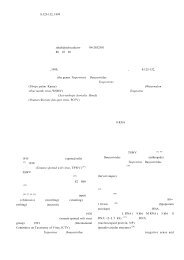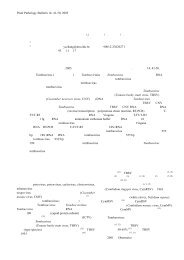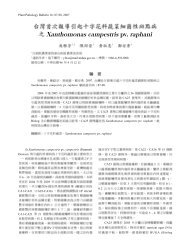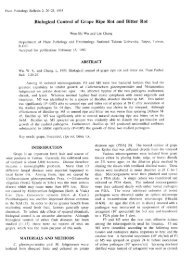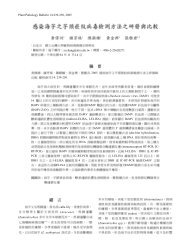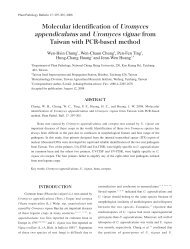Pantoea agglomerans MB-9
Pantoea agglomerans MB-9
Pantoea agglomerans MB-9
Create successful ePaper yourself
Turn your PDF publications into a flip-book with our unique Google optimized e-Paper software.
6615 1 2006<strong>MB</strong>-9 <strong>Pantoea</strong> <strong>agglomerans</strong> BCRC10380Table 2. Cultural, physiological and biochemical characteristics of <strong>MB</strong>-9 strain and <strong>Pantoea</strong> <strong>agglomerans</strong> BCRC10380Cultural, physiological andBacterial strainsbiochemical characteristics <strong>MB</strong>-9 <strong>Pantoea</strong> <strong>agglomerans</strong> CCRC10380Blue pigment -1 -Yellow pigment + +Glucose fermentation + +-galactosidase + +Arginine dihydrolase - -Lysine decarboxylase - -Ornithine decarboxylase - -Citrate utilization + +H2S production from sodium thiosulphate - -Urease - -Tryptophan deaminase - -Indole production - -Acetoin production + +Cytochrome oxidase - -Nitrate reduction + +Phenylalanine deaminase + NDCatalase activity + +Casein hydrolysis - NDPectate degradation - -Salt tolerance (10%) - -Salt tolerance (5%) + +1+, positive; -, negative2ND, not determinedP. <strong>agglomerans</strong><strong>Pantoea</strong> <strong>agglomerans</strong> (syn. E. herbicola)(LITERATURE CITED)1. Ann, P. J. 1993. Effect of climate on development ofmango bacterial black spot and chemical control. PlantPathol. Bull. 2:12-19. (in Chinese with Englishabstract)2. Ann, P. J., Huang, R. C. and Chen, M. F. 1994. Effectsof environmental factors on disease incidence ofmango anthracnose. Plant Pathol. Bull. 3:34-44. (inChinese with English abstract)3. Bonaterra, A., Mari, M., Casalini, L. and Montesinos,E. 2003. Biological control of Monilinia laxa andRhizopus stolonifer in postharvest of stone fruit by<strong>Pantoea</strong> <strong>agglomerans</strong> EPS125 and putativemechanisms of antagonism. In. J. Food Microbiol. 84:93-104.4. Braun-Kiewnick, A., Jacobsen, B. J. and Sands, D. C.2000. Biological control of Pseudomonas syringae pv.syringae, the causal agent of basal kernel blight ofbarley, by antagonistic <strong>Pantoea</strong> <strong>agglomerans</strong>.Phytopathology 90: 368-375.5. Chase, A. R.1984. Leaf spot diseasses of Dracaenasanderana caused by two species of Erwinia. Plant Dis68:2516. Cooksey, D. A.1986. Galls of Gypsophila paniculatacaused by Erwinia herbicola. Plant Dis. 70:464-4687. Cots, J., and Widmer, F. 1999. Germination,senescence and pathogenic attack in soybean (Glycinemax. L.): identification of the cytosolic aconitaseparticipating in the glyoxylate cycle. Plant Sci. 149:95-1048. Gavini, F., Mergaert, J., Beji, A., Mielcarek, C., Izard,D., Kersters, K., and de Ley, J. 1989. Transfer ofEnterobacter <strong>agglomerans</strong> (Beijerinck 1888) Ewing
<strong>Pantoea</strong> <strong>agglomerans</strong> 67and Fife 1972 to <strong>Pantoea</strong> gen. nov. as <strong>Pantoea</strong><strong>agglomerans</strong> comb. nov. and description of <strong>Pantoea</strong>dispersa sp. nov. Int. J. Syst. Bacteriol. 39:337-345.9. Gerhardt, P. 1981.Manual of Methods for GeneralBacteriology. American Society for Microbiology.Washington. 524pp.10. Holt, J. G. 1984. Bergey's Manual of SystematicBacteriology. Vol. 1. Williams & Wilkins, London.964pp.11. Hsieh, T. F., Huang, H. C. and Erickson, R. S. 2005.Biological control of bacterial wilt of bean using abacterial endophyte, <strong>Pantoea</strong> <strong>agglomerans</strong>. J.Phytopathol. 153:608-614.12. Huang, T. C. 1986. Studies on the detectionTechniques for Xanthomonas campestris pv.campestris in Taiwan. Master Thesis. National Chung-Hsing University. 133pp. (in Chinese with Englishabstract)13. Jones, M. and Bell, A. 2004. Association of <strong>Pantoea</strong><strong>agglomerans</strong> with seed rot of South Carolina cotton.Phytopathology 94:s69.14. Koch, M. F., Taanami, Z., and Levy, E. 1996. Damageto garlic crops caused by Erwinia herbicola.Phytoparasitica 24:125-126.15. Kritzman, G. and Zutra, D. 1984. Stalk blight of onion,a new disease in Israel caused by Erwinia herbicola. p.83. Spec. Publ. Agric. Res. Org., Bet Dagan no. 225.16. Mansvelt, E. L., Harding-Goodman, A., and Hattingh,M. J. 1985. Histopathology of seed stalk necrosis ofonion caused by Erwinia herbicola. Phytophylactica17: 41-45.17. Moline, H. E. and Kulik, M. M. 1997. Contaminationand deterioration of alfalfa sprouts caused by aseedborne isolate of Erwinia herbicola. J. Food Qual.20:53-60.18. Morales, N., Vietinghoff, J., Angeles Peres, M. de losRosa, M. de la Moreno, A., Cuello, I. and Seidel, D.1994. Erwinia herbicola (Lohnis) Dye a newpathogen of onion seed production (Allium cepa L.) inCuba. Arch. Phytopathol. Plant Prot. 29:29-40.19. Nunes, C., Usall, J., Teixido, N., Fons, E. and Vinas, I.2002. Post-harvest biological control by <strong>Pantoea</strong><strong>agglomerans</strong> (CPA-2) on Golden Delicious apples. J.Appl. Microbiol. 92: 247-255.20. Pusey, P. L. 1999. Selection and field testing of<strong>Pantoea</strong> <strong>agglomerans</strong> strain E325 for biocontrol offire blight of apple and pear. Phytopathology 89:s62.
6815 1 2006ABSTRACTLee, M. H. 1,2 , and Tzeng, D. D. S. 1 2006. <strong>Pantoea</strong> <strong>agglomerans</strong> <strong>MB</strong>-9 is a potential pathogen causingnecrosis on mongo leaf. Plant Pathol. Bull. 15:63-68. ( 1 Department of Plant Pathology, NationalChung-Hsing University, Taichung, Taiwan; 2 Corresponding author, E-mail: mhlee@nchu.edu.tw;Fax: +886-4-2287-7585)Mango is one of the most important tropic fruits in Taiwan. Necrotic lesions are commonlyfound on ripen fruits of native mango and cultivar 'Irwin". Eighteen bacterial strains were isolatedfrom necrotic lesions of native mango fruits. Wound inoculation showed that strain <strong>MB</strong>-9 causednecrosis on immature and mature mango leaves of native mango and cultivar 'Irwin". Immaturemango leaf wound inoculated with serially diluted bacterial suspensions of <strong>MB</strong>-9 strain revealed thatinoculation with 200 CFU was able to cause necrotic symptom. Bacterial identification based onmicroscopic, cultural, physiological and biochemical characteristics and serological reactionsindicates that <strong>MB</strong>-9 strain was <strong>Pantoea</strong> <strong>agglomerans</strong> (syn. Erwinia herbicola). This study indicatedthat P. <strong>agglomerans</strong> <strong>MB</strong>-9 is a potential pathogen causing necrosis on mango leaf.Key words: <strong>Pantoea</strong> <strong>agglomerans</strong>, Erwinia herbicola, mango leaf necrosis, physiological andbiochemical tests, serological reaction, bacterial identification



